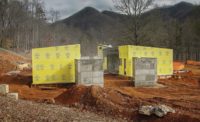Although smoke detectors are essential for safety and mandated by the NFPA (National Fire Protection Association), traditional, bulky models mounted on ceilings or walls in high end residential homes can interrupt – even ruin – the overall design and feel of a space.
As a result, many affluent homeowners are seeking out alternative solutions that allow for the discreet placement and even concealment of smoke detectors.
For some, this has meant adopting more advanced technology used in commercial spaces that not only provides early detection and warning, but does so using very small, discreet “sampling points” the size of a quarter that can be painted or hidden away completely.
“Homeowners do not want to take the focus away from vaulted ceilings, furnishings or extravagant finishes by installing traditional smoke detectors,” says Queen Gonzalez, a co-founder of Intelligent Fire Systems & Solutions, Inc., a fire and life safety installation company based in Southern California. “This is driving a demand for recessed, hidden or concealed smoke detection.”
Traditional smoke detectors tend to be quite large, often seven inches or more in diameter. Having to install such units in just about every room can be a challenge for interior designers, with the available solutions rarely appeasing affluent homeowners with high expectations.
Fortunately, Gonzalez and Intelligent Fire Systems Co-Founder Chris Santamaria had experience installing a sophisticated, unobtrusive smoke detection system called the VESDA-E VEA from Xtralis, an innovator in fire prevention equipment.
In several recent projects, Intelligent Fire Systems installed the VEA system in luxury homes ranging in size from 5,000-20,000 sq. ft. throughout Los Angeles and neighboring counties.
Used for decades in the most sensitive smoke detection applications, the VESDA (Very Early Smoke Detection Apparatus) system from Xtralis, an innovator in fire prevention equipment, is now available in a simplified commercial version – the VEA – that is increasingly crossing over into the residential market.
Instead of typical bulky smoke detectors that passively detect smoke, the VEA system instead draws in air from each room or space through small, flexible tubing. The air is then analyzed at a remote unit for the presence of minute smoke particles in a continuous process.
Because the tubing is only 6 mm thick (thinner than a pencil), the system’s sampling points are very small and unobtrusive.
“You can get creative in concealing the sampling points so they blend in with the surroundings,” says Santamaria. “The sampling points can even be concealed in ceilings with multiple types of finishes including plaster, wood, marble, or behind crown molding. All that is required is a small point of entry for the sampling tube.”
Mike Hard, President of Hardfire, an engineered special hazards and fire alarm company based in Ohio, has also had requests from affluent homeowners for more discreet solutions to smoke detection.
One recent case involved a project in an elegant residential neighborhood in Ohio that involved a 12,000 sq. ft. home with an extensive art collection. Another project was for a designer home that essentially had a small, attached museum, built to approximately a 30,000 sq. ft. footprint.
“We suggested the Xtralis VEA system because of its discreetness,” says Hard. “Each sampling point is very subtle – about the size of a quarter. We even painted the sampling points the same color as the ceiling and walls, so it blends in very nicely.”
With the VEA system, the analyzer can be installed in a central room or closet. This has the added benefit of allowing for regular testing, service and maintenance to be performed at the analyzer without having to enter homeowners’ bedrooms or other private areas. This is a major selling point for homeowners over traditional smoke and CO monitoring systems that should be checked manually on a regular basis.
According to Hard, after completing the project several of the homeowner’s neighbors contacted him based on word-of-mouth to install the VEA system in their homes as well.
Safeguarding Life and Property
Beyond improved aesthetics, advanced technologies like the VEA also provide significantly earlier smoke detection. This can enable a swift response that saves lives and limits property damage.
The VEA system, in fact, is able to detect minor particles in the air considerably faster than a passive smoke detector, even before a fire starts to flame and burn. In many instances, this ability to get a very early warning of a fire in one area can help prevent it from spreading to other areas.
“If there is a small, smoldering fire, the active air sampling VEA system will detect it much faster than a passive traditional detector,” says Hard. “It goes above and beyond [fire] code for better protection.”
The VEA system analyzes air using sophisticated laser-based technology at a central unit. As a multi-channel, addressable system, the central unit can pinpoint the exact location of the alarm. A single system supports up to 40 sample points and can be extended to 120.
“Since the Xtralis system is addressable, it tells you exactly where the smoke is so fire response is faster as well,” says Hard. “Homeowners do not have to run to every room if the detector triggers an alarm.”
Although smoke detectors have long been mandated to protect lives, with more subtle and effective choices now available, homeowners and architects no longer have to settle for units that compromise the cohesiveness of their interior design.








Report Abusive Comment